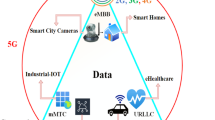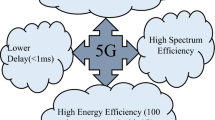Abstract
Some channel coding schemes for 5G mobile communication system is facing difficulty in satisfying the user requirements in machine-type communication. This paper evaluates different channel coding schemes (LDPC, turbo, polar, systematic convolutional, and non-systematic convolutional codes) on an AWGN channel with BPSK modulation of code rate 1/2, in order to suggest the optimum channel coding scheme for the 5G mobile communication system for short length message transmission in machine-type communication. The analysis of the different channel coding schemes is based on flexibility, complexity, latency, and reliability according to the user requirements in machine-type communication. The main user requirements of machine-type communication for 5G channel coding scheme are better flexibility, low complexity, low latency, and high reliability in communication. Hence, the evaluation of different channel coding schemes is mainly based on satisfying user requirements in machine-type communication. The evaluation of the results shows that the systematic convolutional code is the optimum channel coding scheme in terms of better flexibility, low encoding computational latency, and higher reliability for the 5G mobile communication system for short length message transmission (\(k \le 1024\) bits) in machine-type communication. Whereas, the polar code has the lowest decoding computational complexity.


















Similar content being viewed by others
References
Sharma, A., & Salim, M. (2017). Polar code: The channel code contender for 5G scenarios. In 2017 international conference on computer, communications and electronics (Comptelix), 1–2 July 2017, Jaipur, India, IEEE (pp. 676–682).
Gamage, H., Rajatheva, N., & Latva-aho, M. (2017). Channel coding for enhanced mobile broadband communication in 5G systems. In 2017 European conference on networks and communications (EuCNC), 12 June 2017, IEEE (pp. 1–6).
Rodriguez, J. (2015). Fundamentals of 5G mobile networks (p. 8). United Kingdom: Wiley.
Shariatmadari, H., Ratasuk, R., Iraji, S., Laya, A., Taleb, T., Jntti, R., et al. (2015). Machine-type communications: Current status and future perspectives toward 5G systems. IEEE Communications Magazine, 53(9), 10–17.
Maunder, R. G. (2016). The 5G channel code contenders. AccelerComm white paper (pp. 1–13). https://eprints.soton.ac.uk/399915/1/WhitePaper09Aug2016.pdf.
Osseiran, A., Monserrat, J. F., & Marsch, P. (2016). Machine-type communications, in 5G mobile and wireless communications technology (pp. 77–106). United Kingdom: Cambridge University Press.
Ericsson. (2016). 5G radio access. Ericsson white paper (pp. 1–10). https://www.ericsson.com/assets/local/publications/white-papers/wp-5g.pdf.
Iscan, O., Lentner, D., & Xu, W. (2016). A comparison of channel coding schemes for 5G short message transmission. In 2016 IEEE globecom workshops (GC Wkshps), IEEE (pp. 1–6).
Bockelmann, C., Pratas, N., Nikopour, H., Au, K., Svensson, T., Stefanovic, C., et al. (2016). Massive machine-type communications in 5G: Physical and MAC-layer solutions. IEEE Communications Magazine, 54(9), 59–65.
Sklar, B. (2001). Channel coding: Part 2, in digital communications: Fundamentals and applications (2nd ed., pp. 382–435). Upper Saddle River, New Jersey: Prentice Hall PTR.
Viterbi, A., & Omura, J. (1979). Principle of digital communication and coding. New York: MCGraw-hill, Inc.
Wicker, S. B. (1995). Error control systems for digital communication and storage (Vol. 1). Englewood Cliffs: Prentice Hall.
Çalhan, A., Çeken, C., & Ertürk, İ. (2009). A teaching demo application of convolutional coding techniques for wireless communications. In International conference on application of information and communication technologies, 2009. AICT 2009, 14 October 2009, IEEE (pp. 1–5).
Odenwalder, J. P. (1970). Optimal decoding of convolutional codes. Ph.D. dissertation, University of California.
Larsen, K. (1973). Short convolutional codes with maximal free distance for rates 1/2, 1/3, and 1/4 (corresp.). IEEE Transactions on Information Theory, 19(3), 371–372.
Rao, K. D. (2015). Channel coding techniques for wireless communications. Springer, India.
Bahl, L., Cocke, J., Jelinek, F., & Raviv, J. (1974). Optimal decoding of linear codes for minimizing symbol error rate (corresp.). IEEE Transactions on Information Theory, 20(2), 284–287.
Vucetic, B., & Yuan, J. (2000). Turbo codes: Principles and applications. New York: Springer.
MATLAB: Turbo encoder. R2017b Documentation, ed.: MathWorks. http://www.mathworks.com/help/comm/ref/turboencoder.html (2017).
Gallager, R. (1962). Low-density parity-check codes. IRE Transactions on information theory, 8(1), 21–28.
Fan, J. L. (2000). Array codes as low-density parity-check codes. In Proceedings of 2nd international symposium on turbo codes, Brest, France, September 2000 (pp. 543–546).
Honary, B., Lin, S., Gabidulin, E., Xu, J., Kou, Y., Moinian, A. et al. (2004). On construction of low density parity check codes. In 2nd international workshop on signal processing for wireless communication (SPWC 2004), 2–4 June 2004 (pp. 11–26).
Tanner, R. (1981). A recursive approach to low complexity codes. IEEE Transactions on Information Theory, 27(5), 533–547.
Richardson, T. J., & Urbanke, R. L. (2001). Efficient encoding of low-density parity-check codes. IEEE Transactions on Information Theory, 47(2), 638–656.
Arikan, E. (2009). Channel polarization: A method for constructing capacity-achieving codes for symmetric binary-input memoryless channels. IEEE Transactions on Information Theory, 55(7), 3051–3073.
Arikan, E. (2011). Systematic polar coding. IEEE Communications Letters, 15(8), 860–862.
Vangala, H., Hong, Y., & Viterbo, E. (2016). Efficient algorithms for systematic polar encoding. IEEE Communications Letters, 20(1), 17–20.
Li, L., & Zhang, W. (2015). On the encoding complexity of systematic polar codes. In 2015 28th IEEE international system-on-chip conference (SOCC), IEEE (pp. 415–420).
Tahir, B., Schwarz, S., & Rupp, M. (2017). BER comparison between convolutional, turbo, LDPC, and polar codes. In 2017 24th international conference on telecommunications (ICT), 3 May 2017, IEEE (pp. 1–7).
Chen, G. T., Zhang, Z., Zhong, C., & Zhang, L. (2016). A low complexity encoding algorithm for systematic polar codes. IEEE Communications Letters, 20(7), 1277–1280.
Tal, I., & Vardy, A. (2015). List decoding of polar codes. IEEE Transactions on Information Theory, 61(5), 2213–2226.
Niu, K., & Chen, K. (2012). CRC-aided decoding of polar codes. IEEE Communications Letters, 16(10), 1668–1671.
Sybis, M., Wesolowski, K., Jayasinghe, K., Venkatasubramanian, V., & Vukadinovic, V. (2016). Channel coding for ultra-reliable low-latency communication in 5G systems. In 2016 IEEE 84th vehicular technology conference (VTC-Fall), 18 September 2016, IEEE (pp. 1–5).
Kienle, F., Wehn, N., & Meyr, H. (2011). On complexity, energy- and implementation-efficiency of channel decoders. IEEE Transactions on Communications, 59(12), 3301–3310.
Hong, S., & Stark, W. E. (1999). Power consumption vs. decoding performance relationship of VLSI decoders for low energy wireless communication system design. In The 6th IEEE international conference on electronics, circuits and Systems, 1999. Proceedings of ICECS’99. 1999, IEEE (pp. 1593–1596).
Declercq, D., Fossorier, M., & Biglieri, E. (2014). Hardware design and realization for iteratively decodable codes. In Channel coding: Theory, algorithms, and applications. Academic Press Library in Mobile and wireless communications (1st ed., p. 620). Oxford: Academic Press Elsevier.
Hassan, A. E. S., Dessouky, M., Elazm, A. A., & Shokair, M. (2012). Evaluation of complexity versus performance for turbo code and LDPC under different code rates. In Proc. SPACOMM 2012: The Fourth International Conference on Advances in Satellite and Space Communications (pp. 98–103). Egypt.
Fagervik, K., & Larssen, A. S. (2003). Performance and complexity comparison of low density parity check codes and turbo codes. In Proceedings of Norwegian signal processing symposium (NORSIG’03) (pp. 2–4).
Viterbi, A. (1971). Convolutional codes and their performance in communication systems. IEEE Transactions on Communication Technology, 19(5), 751–772.
Jiang, Y. (2010). A practical guide to error-control coding using Matlab. Artech House.
Maiya, S. V., Costello, D. J., & Fuja, T. E. (2012). Low latency coding: Convolutional codes vs. LDPC codes. IEEE Transactions on Communications, 60(5), 1215–1225.
Hehn, T., & Huber, J. B. (2009). LDPC codes and convolutional codes with equal structural delay: A comparison. IEEE Transactions on Communications, 57(6), 1683–1692.
Eslami, A., & Pishro-Nik, H. (2010). On bit error rate performance of polar codes in finite regime. In 2010 48th Annual Allerton conference on communication, control, and computing (Allerton), 29 September 2010, IEEE (pp. 188–194).
Author information
Authors and Affiliations
Corresponding author
Additional information
Publisher's Note
Springer Nature remains neutral with regard to jurisdictional claims in published maps and institutional affiliations.
Rights and permissions
About this article
Cite this article
Hajiyat, Z.R.M., Sali, A., Mokhtar, M. et al. Channel Coding Scheme for 5G Mobile Communication System for Short Length Message Transmission. Wireless Pers Commun 106, 377–400 (2019). https://doi.org/10.1007/s11277-019-06167-7
Published:
Issue Date:
DOI: https://doi.org/10.1007/s11277-019-06167-7




